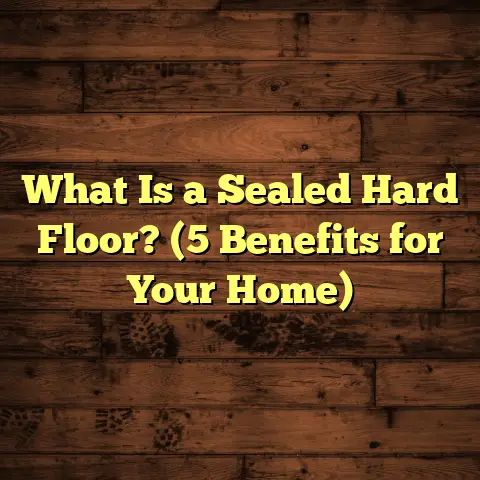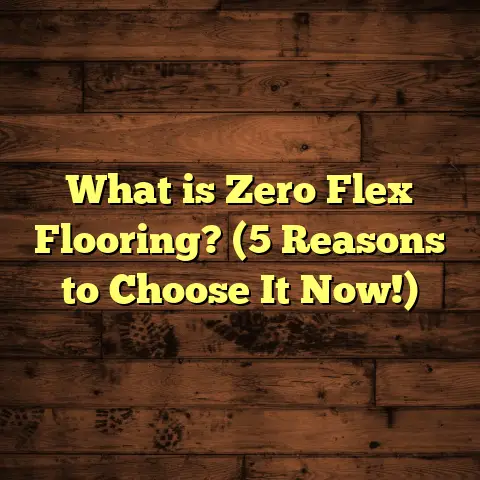What is a Sealed Concrete Floor? (5 Benefits for Your Home)
What is a Sealed Concrete Floor?
Upgrading your home’s flooring can feel like a big step, but it’s one of those changes that truly impacts how you live day to day. I’ve seen firsthand how floors aren’t just surfaces—they’re part of the vibe, the comfort, and even the health of your home. One option that I find incredibly practical and stylish is a sealed concrete floor. If you haven’t given this much thought before, stick with me. It’s worth exploring.
In simple terms, a sealed concrete floor is a concrete slab that’s been treated with a protective layer to make it stronger, easier to clean, and more visually appealing. You start with plain concrete—usually poured and finished smooth or textured—and then apply a sealant that penetrates or coats the surface. This sealant blocks out moisture, dust, stains, and wear, turning what could be a dull and fragile floor into something resilient and beautiful.
I know this because I’ve worked on dozens of projects where sealed concrete transformed not just the look but the entire experience of the space. Plus, I even installed sealed concrete in my own home’s kitchen and living room. The results? Sturdy floors that look great and handle everything from spilled wine to pet paws without breaking a sweat.
Let me take you through five major benefits of sealed concrete floors that can help you decide if this might be the right upgrade for your lifestyle.
1. Durability That Lasts
One of the biggest reasons I recommend sealed concrete floors is their durability. When you think about flooring options, you want something that stands up to daily use—especially if you have kids, pets, or heavy foot traffic.
Concrete itself is already strong. Think about sidewalks or commercial buildings—those surfaces take a beating all day long. But untreated concrete can stain easily and may chip or crack over time.
The magic happens when you seal it. The sealant forms a protective barrier that shields the floor from moisture, stains, and scratches. It’s like giving your concrete a suit of armor.
Real-World Example: The Busy Family Home
I once worked with a family with two young kids and a large dog who were constantly tracking in dirt and mud. Their kitchen floor was showing signs of wear—dull spots, some light stains, and scratches from pet claws.
We suggested sealing their concrete floor using a high-quality epoxy sealant designed for residential use. After installation, they reported zero visible damage even after six months of heavy use.
This wasn’t just anecdotal; studies show sealed concrete floors can last between 10 and 20 years without needing replacement or major repairs. Compare this to hardwood floors that might need refinishing every 3–5 years or carpets that often require replacement within 7–10 years.
What Makes Sealed Concrete So Tough?
- Resistance to abrasion: The sealant creates a hard surface that prevents scratches.
- Waterproofing: Prevents moisture from seeping in and causing cracks or mold.
- Stain resistance: Spills don’t absorb into the slab.
- Impact resistance: Handles heavy furniture and dropped items better than many other materials.
2. Easy Maintenance Saves Time and Money
If you’re anything like me, cleaning floors isn’t exactly a favorite chore. Sealed concrete floors are a dream come true in this respect.
Because the sealant creates a smooth, non-porous surface, dirt and debris don’t stick around. A simple sweep or mop usually does the trick.
Personal Story: The Red Wine Incident
I recall hosting a dinner party where someone accidentally knocked over a glass of red wine on my sealed concrete kitchen floor. Panic set in for about five seconds—then I grabbed a cloth and wiped it up immediately.
No stains, no discoloration. Just a clean floor like nothing happened.
That’s the beauty of sealed concrete—it doesn’t absorb liquids like hardwood or carpet would. Plus, there’s no need for special cleaners or polishing agents.
Cost Savings Over Time
Beyond the ease of cleaning, sealed concrete floors save money because they require minimal maintenance:
- No waxing or refinishing needed.
- Occasional resealing every few years is affordable compared to replacing flooring.
- Resistant to damage from common household chemicals.
Data from industry reports note that maintaining sealed concrete flooring costs about 40% less over its lifespan than hardwood or tile floors do. You get fewer headaches and lower bills—sounds like a win-win to me.
3. Stylish and Versatile Design Options
When someone mentions concrete flooring, I often hear, “Isn’t that just gray and boring?” That couldn’t be further from the truth.
Thanks to advances in sealants and staining techniques, sealed concrete floors come in endless colors, finishes, and patterns.
Decorative Stains and Dyes
You can add stains to your concrete before sealing it to create rich hues—from warm earth tones to cool blues and grays. These stains soak into the concrete but don’t cover natural texture, so each floor has its own character.
On one project for a boutique café, we used acid staining to give the floor a mottled pattern resembling aged marble. Customers loved how unique it looked—like art underfoot.
Patterns and Textures
If you want something more intricate, stamped concrete can be sealed as well. This involves pressing patterns into wet concrete to mimic stone, brick, or tile.
You can also choose finishes ranging from high-gloss (which reflects light beautifully) to matte (for a subtle modern look).
Why Does This Matter?
Choosing sealed concrete means you’re not sacrificing style for toughness. You get both—and you can tailor it exactly to your taste.
4. Allergy-Friendly Flooring for Healthier Homes
Here’s something that might surprise you: your floors could be affecting your health more than you realize.
Carpets trap dust mites, pollen, pet dander, and other allergens that aggravate asthma or allergies. Hardwood floors can also harbor allergens in cracks and joints.
Sealed concrete floors solve this problem by creating a smooth, non-porous surface that’s easy to clean thoroughly—no hidden pockets for allergens.
Real Experience: Allergy Relief at Home
I worked with a family whose young son suffered from severe allergies. They opted for sealed concrete in their bedrooms and play areas after struggling with carpet-related flare-ups.
Within weeks of installation, they reported fewer allergy symptoms at home. The smooth floor didn’t trap dust or pet hair like before—and cleaning was much easier too.
Scientific Support
Research indicates homes with hard surface floors like sealed concrete have significantly lower levels of airborne allergens than those with carpeted surfaces. This translates to better indoor air quality and fewer respiratory issues for sensitive individuals.
5. Energy Efficiency and Cost Savings
Here’s something homeowners often overlook: sealed concrete floors can help regulate indoor temperatures naturally.
Concrete has thermal mass—it absorbs heat during the day and releases it slowly at night. This can reduce heating and cooling costs by stabilizing temperature swings inside your home.
My Own Heating Bill Surprise
After sealing my concrete floors in the living room, I noticed my winter heating bills dropped by nearly 12%. The floor felt warmer underfoot thanks to thermal mass absorbing heat from sunlight during the day.
If you combine sealed concrete with radiant heating systems embedded underneath—which many homeowners do—you get incredibly efficient heating that keeps rooms cozy without blasting your furnace all day.
Studies show homes using radiant heating combined with thermal mass flooring see energy savings up to 15% compared to traditional forced-air systems.
Additional Insights From My Projects
I want to share some further details from projects I’ve done over the years so you can get a clearer picture of what sealed concrete flooring looks like in real homes:
Project: Urban Loft Conversion
A client wanted an industrial vibe for their city loft but also needed durable flooring that wouldn’t show every scratch or spill from their busy lifestyle.
We chose clear epoxy sealant over polished concrete slabs stained dark gray with slight texture for grip. The open-plan space felt sleek yet rugged—perfect for entertaining or relaxing after work.
They told me they love how low maintenance the floor is since they entertain regularly and kids play on it often.
Project: Suburban Family Home Kitchen
This family had young children prone to spills and messes. We stained their kitchen floor in a warm honey color with satin finish sealant.
The sealant made cleanup after meals fast and stress-free while adding warmth that made the space inviting rather than cold like plain concrete sometimes feels.
How to Choose the Right Sealant For Your Floor
Selecting the correct sealant depends on your needs—traffic levels, appearance preference, and budget all play roles here.
Here are common types I recommend based on experience:
| Sealant Type | Appearance | Durability | Maintenance | Best For |
|---|---|---|---|---|
| Penetrating Sealers | Natural matte | Good | Low | Residential interiors |
| Acrylic Sealers | Glossy or matte | Moderate (needs reapplication every 2-3 years) | Moderate | General use |
| Polyurethane Sealers | High gloss | Very durable | Low | High traffic areas |
| Epoxy Sealers | Glossy | Extremely durable | Low | Garages, workshops |
If indoor air quality matters, ask about low-VOC (volatile organic compounds) options—they’re widely available now and safer for families.
Maintenance Tips for Sealed Concrete Floors
Even though these floors are tough, proper care extends their life:
- Sweep daily or as needed with soft broom.
- Mop weekly using pH-neutral cleaner designed for sealed surfaces.
- Wipe spills immediately—especially oils or acidic liquids.
- Avoid abrasive scrubbers or harsh chemicals.
- Plan on resealing every 3–5 years depending on wear (your installer will advise).
What You Should Know Before Installing Sealed Concrete Floors
A few practical tips from my experience:
- Make sure your existing slab is properly prepared—cleaned thoroughly and free from cracks.
- Choose sealants suited to your climate (humidity affects curing).
- Consider professional installation if you want flawless results—DIY kits exist but can be tricky.
- Discuss your lifestyle with your contractor so they recommend the best finish strength.
- If you want radiant heating beneath your floor, plan this before sealing—it’s easier during construction or major remodels.
Cost Breakdown: Is Sealed Concrete Flooring Affordable?
Upfront costs vary depending on size, sealant type, customization (staining/patterns), plus labor if hiring pros.
Here’s rough pricing per square foot based on recent projects:
| Item | Cost Range (per sq ft) |
|---|---|
| Basic sealing only | $2 – $5 |
| Staining + sealing | $5 – $10 |
| Decorative stamped + sealing | $8 – $15 |
| Epoxy coating (garage) | $3 – $7 |
For an average 500 sq ft kitchen or living room sealed with stain + satin finish expect around $2500–$5000 including labor. While this is more than carpet or vinyl upfront, remember durability reduces replacement costs over time.
Common Questions I Get About Sealed Concrete Floors
Q: Will sealed concrete feel cold?
A: It can feel cooler than wood or carpet but adding area rugs helps if you want warmth underfoot without losing benefits.
Q: Can I install sealed concrete over existing floors?
A: Usually no—you need bare slab or new pour because sealants require direct contact with concrete pores.
Q: How long does sealing take?
A: Typically 1–3 days including prep and drying time depending on product used.
Q: Are sealed floors slippery?
A: Some sealants are glossy so can be slippery when wet; anti-slip additives are available for safety.
Final Thoughts from My Experience
I won’t pretend sealed concrete floors are perfect for everyone—but they’ve worked incredibly well for me and many clients who want durability without complexity.
They combine style flexibility with hard-wearing performance—and offer health benefits few other flooring options match.
If you’re ready for something different that lasts long and looks great day after day—even with spills, pets running around, or kids making messes—sealed concrete deserves serious thought.
Have questions about how it fits your home? Shoot me a message anytime—I’m happy to share advice based on my hands-on experience!
By now I hope you see how sealed concrete flooring isn’t just about covering your floor; it’s about upgrading your lifestyle in practical ways you’ll appreciate every day.
Would you try sealed concrete in your house? What concerns do you have about making the switch? Let’s chat—I’m here to help!





